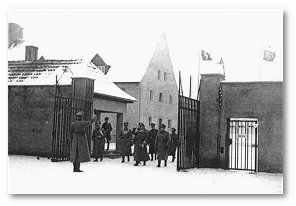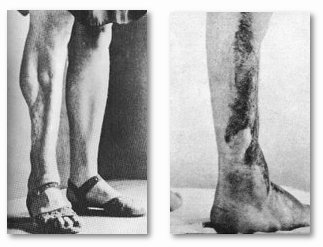|
|

| RAVENSBRUCK CONCENTRATION CAMP

Main entrance to Ravensbrueck |
Ravensbruck was located 90 km from Berlin. It was founded in 1938 by SS Leader Heinrich Himmler. May 15, 1939 the camp opened. What made it unusual was that it was a camp primarily for women. There were children in the camp as well. They arrived with mothers who were Jews or Gypsies, or were born to prisoners while in captivity. In 1942 a few Czech children entered the camp from Lidice. Later, the children in the camp represented most of the nations of Europe occupied by Germany. |
Between April and Oct. of 1944 their numbers increased considerably, consisting of 2 groups. One group was comprised of Roma, of Gypsie children with their mothers and sisters who brought them after the camp Gypsy camp in Auschwitz was closed. The other group included mostly children who were brought with Polish mothers to Ravensbruck after the collapse of the Warsaw Uprising in 1944, and Jewish children after the Budapest Ghetto was closed. With a few exceptions, all of these children died of starvation.
Ravensbruck served as a training camp for over 4,000 female overseers. The technical term for a female guard in a Nazi camp was an Aufseherin. The women either stayed in the camp or eventually served in other camps. The female chief overseers - Oberaufseherinnen - in Ravensbruck were:
- May 1939 - May 1941 ~ Jane Bernigau, with deputy wardress Anne Zimmer
- May 1941 - June 1942 ~ Johanna Langefeld
- June 1942 - Oct. 1942 ~ Maria Mandel
- Oct. 1942 - April 1945 ~ Johanna Langefeld returned
Later, several women were head female guards at the same time.
- 1942 - 1944 ~ Anne Klein
- 1944 - 1945 ~ Erna Rose
- 1944 - 1945 ~ Margarete Gallinat
- 1944 ~ Kaethe Hoern
- 1944 ~ Elsa Erich
- 1944 ~ Hildegard Neumann
- 1944 ~ Hermine Braunsteiner
- 1944 ~ Else Webber
Most of these women went on to serve as chief wardresses in other camps. Other high ranking SS women included:
- Christel Jankowsky
- Ilse Goeritz
- Greta Boesel
- Margot Dreschel
- Elisabeth Kammer
The treatment by the SS women in Ravensbruck was normally brutal. Elfriede Muller, an SS Aufseherin in the camp, was so harsh that the prisoners nicknamer her "The Beast of Ravensbruck".
When a new prisoner arrived at Ravensbruck they were required to wear a color-coded triangle, a winkel, that identified them by category with a letter sewn within the triangle that indicated the prisoner's nationality. Polish women wore red triangles - red denoting a political prisoner - with a letter "P". By 1942, Polish women became the largest national component at Ravensbruck. Jewish women wore yellow triangles, but sometimes unlike the other prisoners, they wore a second triangle for the other categories or for "Race Defilement". Some transports had their head shaved, such as from Czechoslovakia and Poland, but "Aryan" transports did not. For instance, in 1943 a group of Norwegian women came to the camp. None had their hair shaved. Between 1942 and 1943 almost all Jewish women from the Ravensbruck camp were sent to Auschwitz in several transports following Nazi policy to make Germany "Judenrein" (cleansed of Jews).
Based on the Nazi's incomplete transport list "Zugangsliste" consisting of 25,028 names of women sent by Nazi's to the camp, it's estimated that the inmates of Ravensbruck ethnic structure was as follows:
|
Poles 24.9% |
Germans 19.9% |
|
Jews 15.1% |
Russians 15.0% |
|
French 7.3% |
Gypsies 5.4% |
|
The list was one of the most important documents, preserved in the last moments of the camp by courageous members of the Polish Underground girl guides Unit "Mury" (the Walls). The rest of the camp documents were burned by escaping SS overseers in pits or in the crematorium.
One of the forms of the resistance were underground education programs organized by prisoners for their fellow inmates. All national groups had some sort of program. The most extensive were among the Polish women where various high school level classes were taught by experienced teachers.
|

Experiments at Ravensbrueck |
Inmates at Ravensbruck suffered greatly. Living in subhuman conditions; thousands were shot, strangled, buried alive, or worked to death. Special methods of torture were medical experiments conducted on 86 women; 74 of them were Polish inmates. There were 2 types of experiments done on the Polish political prisoners. The 1st one aimed at testing the efficiency of Sulphanamide drugs. These experiments involved the deliberate cutting out and infection of bones and muscles of the legs with virulent bacteria, the cutting out of nerves, the introduction of virulent substances like pieces of wood or glass into the tissue, and the causing of artificial bone fractures. |
The 2nd study aimed at studying the processes of regeneration of bones, muscles, and nerves, and also the possibilities of transplanting bones from one person to another. ALL of the experiments were done against the will and despite the open protests from the victims involved. 5 of the Polish victims died as a result of the experiments. 6 others were executed in the camp. The rest of the "rabbits", as they were called, survived thanks to the help of the other inmates in the camp.
Between 120 and 140 Gypsy women were sterilized in the cmp in 1945. All of them, unaware of the consequences, signed the camp consent form after being told by the camp overseers that the German authorities would release them if they agreed to be sterilized.
All inmates were required to do heavy labor. The women were forced to work many kinds of slave labor, from heavy outdoor jobs, to building V-2 Rocket parts for the German company Siemans AG. Ravensbruck also supplied every major camp, except Auschwitz, with women to work in the camp brothels. In 1942 the Germans sent 50 female political prisoners with overseers to each of the following camps to work in their brothels; Buchenwald, Dachau, Flossenburg, Mauthausen, Neuengamme, and Sachsenhausen. Most of the women volunteered because they made money, had Sundays and mornings off, received nice clothes, took regular showers, and were treated fairly well. But most subsequently were returned to Ravensbruck after a few months suffering from venereal diseases.
Ravensbruck had a gas chamber and a crematorium, and at the end of 1944 it became a death camp. With the Soviet Army's rapid approach in the spring of 1945, the SS decided to exterminate as many prisoners as possible to avoid leaving anyone to testify against them. With the Russians only hours away, at the end of April, the SS ordered the women still physically able to walk to leave the camp. Less than 2,000 malnourished and sickly women and 300 men remained in the camp when it was liberated in the following hours by a Russian Scout Unit. By the time the liberation came, an estimated 30,000 to 40,000 women had perished there.
The name of the camp appeared in numerous trials held against the Nazi's after WWII. One of those trials was the Doctors Trial. It was held from October 1946 through Feb. 1947 in front of the Military Tribunal, in Nuremberg, Germany.
|

